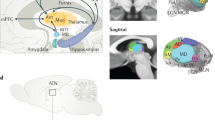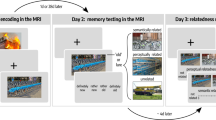Abstract
Medial temporal lobe (MTL) lesions typically produce retrograde amnesia characterized by the disproportionate loss of recently acquired memories. Temporally graded memory loss is interpreted traditionally as evidence for a consolidation process guided by the MTL. Here, using functional magnetic resonance imaging (fMRI), we show temporally graded changes in MTL activity in healthy older adults taking a famous faces remote memory test. Evidence for temporally graded change in the hippocampal formation was mixed, suggesting it may participate only in consolidation processes lasting a few years. Entorhinal cortex was associated with temporally graded changes extending up to 20 years. These findings support the basic tenets of consolidation theory and suggest that the entorhinal cortex, rather than the hippocampal formation, participates in memory consolidation over decades.
This is a preview of subscription content, access via your institution
Access options
Subscribe to this journal
Receive 12 print issues and online access
$209.00 per year
only $17.42 per issue
Buy this article
- Purchase on Springer Link
- Instant access to full article PDF
Prices may be subject to local taxes which are calculated during checkout




Similar content being viewed by others
References
Scoville, W. B. & Milner, B. Loss of recent memory after bilateral hippocampal lesions. 1957 [classical article]. J. Neuropsychiatr. Clin. Neurosci. 12, 103–113 (2000).
Squire, L. R. Memory and the hippocampus: a synthesis from findings with rats, monkeys, and humans (erratum, Psychol. Rev. 99, 582, 1992) Psychol. Rev. 99, 195–231 (1992).
Milner, B., Corkin, S. & Teuber, H. L. Further analysis of the hippocampal amnesic syndrome: 14-year follow-up study of H.M. Neuropsychologia 6, 215–234 (1968).
Rempel-Clower, N. L., Zola, S. M., Squire, L. R. & Amaral, D. G. Three cases of enduring memory impairment after bilateral damage limited to the hippocampal formation. J. Neurosci. 16, 5233–5255 (1996).
Squire, L. R., Haist, F. & Shimamura, A. P. The neurology of memory: quantitative assessment of retrograde amnesia in two groups of amnesic patients. J. Neurosci. 9, 828–839 (1989).
Knowlton, B. J. & Fanselow, M. S. The hippocampus, consolidation and on-line memory. Curr. Opin. Neurobiol. 8, 293–296 (1998).
McGaugh, J. L. Memory—a century of consolidation. Science 287, 248–251 (2000).
Squire, L. R. & Alvarez, P. Retrograde amnesia and memory consolidation: a neurobiological perspective. Curr. Opin. Neurobiol. 5, 169–177 (1995).
Ivanco, T. L. & Racine, R. J. Long-term potentiation in the reciprocal corticohippocampal and corticocortical pathways in the chronically implanted, freely moving rat. Hippocampus 10, 143–152 (2000).
Lynch, G. Memory and the brain: unexpected chemistries and a new pharmacology. Neurobiol. Learn. Mem. 70, 82–100 (1998).
Albert, M. S., Butters, N. & Brandt, J. Patterns of remote memory in amnesic and demented patients. Arch. Neurol. 38, 495–500 (1981).
Kapur, N. Syndromes of retrograde amnesia: a conceptual and empirical synthesis. Psychol. Bull. 125, 800–825 (1999).
Kritchevsky, M. & Squire, L. R. Transient global amnesia: evidence for extensive, temporally graded retrograde amnesia. Neurology 39, 213–218 (1989).
Anagnostaras, S. G., Maren, S. & Fanselow, M. S. Temporally graded retrograde amnesia of contextual fear after hippocampal damage in rats: within-subjects examination. J. Neurosci. 19, 1106–1114 (1999).
Fanselow, M. S. Contextual fear, gestalt memories, and the hippocampus. Behav. Brain Res. 110, 73–81 (2000).
Zola-Morgan, S. M. & Squire, L. R. The primate hippocampal formation: evidence for a time-limited role in memory storage. Science 250, 288–290 (1990).
Alvarez, P. & Squire, L. R. Memory consolidation and the medial temporal lobe: a simple network model. Proc. Natl. Acad. Sci. USA 91, 7041–7045 (1994).
McClelland, J. L., McNaughton, B. L. & O'Reilly, R. C. Why there are complementary learning systems in the hippocampus and neocortex: insights from the successes and failures of connectionist models of learning and memory. Psychol. Rev. 102, 419–457 (1995).
Nadel, L. & Moscovitch, M. Memory consolidation, retrograde amnesia and the hippocampal complex. Curr. Opin. Neurobiol. 7, 217–227 (1997).
Albert, M. S., Butters, N. & Levin, J. Temporal gradients in the retrograde amnesia of patients with alcoholic Korsakoff's disease. Arch. Neurol. 36, 211–216 (1979).
Marslen-Wilson, W. D. & Teuber, H.-L. Memory for remote events in anterograde amnesia: recognition of public figures from news photographs. Neuropsychologia 13, 353–364 (1975).
Eichenbaum, H. The hippocampus: the shock of the new. Curr. Biol. 9, R482–484 (1999).
Knight, R. Contribution of human hippocampal region to novelty detection. Nature 383, 256–259 (1996).
Parkin, A. J. Human memory: novelty, association and the brain. Curr. Biol. 7, R768–769 (1997).
Haxby, J. V., Hoffman, E. A. & Gobbini, M. I. The distributed human neural system for face perception. Trends Cogn. Sci. 4, 223–233 (2000).
Kapur, N., Friston, K. J., Young, A., Frith, C. D. & Frackowiak, R.S. Activation of human hippocampal formation during memory for faces: a PET study. Cortex 31, 99–108 (1995).
Leveroni, C. L. et al. Neural systems underlying the recognition of familiar and newly learned faces. J. Neurosci. 20, 878–886 (2000).
Sergent, J., Ohta, S. & MacDonald, B. Functional neuroanatomy of face and object processing. A positron emission tomography study. Brain 115, 15–36 (1992).
Kapur, N. & Brooks, D. J. Temporally-specific retrograde amnesia in two cases of discrete bilateral hippocampal pathology. Hippocampus 9, 247–254 (1999).
Zola-Morgan, S., Squire, L. R. & Amaral, D. G. Human amnesia and the medial temporal region: enduring memory impairment following a bilateral lesion limited to field CA1 of the hippocampus. J. Neurosci. 6, 2950–2967 (1986).
Markowitsch, H. J. in Principles of Behavioral and Cognitive Neurology 2nd edn. (ed. M.-Marsel Mesulam, E.) 257–293 (Oxford Univ. Press, Oxford, UK, 2000).
Cohen, N. J. & Eichenbaum, H. Memory, Amnesia, and the Hippocampal System (MIT Press, Cambridge, Massachusetts, 1993).
Squire, L. R. Memory and the hippocampus: a synthesis from findings with rats, monkeys, and humans. Psychol. Rev. 99, 195–231 (1992).
Thornton, J. A., Rothblat, L. A. & Murray, E. A. Rhinal cortex removal produces amnesia for preoperatively learned discrimination problems but fails to disrupt postoperative acquisition and retention in rhesus monkeys. J. Neurosci. 17, 8536–8549 (1997).
Yoneda, Y., Mori, E., Yamashita, H. & Yamadori, A. MRI volumetry of medial temporal lobe structures in amnesia following herpes simplex encephalitis. Eur. Neurol. 34, 243–252 (1994).
Suzuki, W. A. & Amaral, D. G. Perirhinal and parahippocampal cortices of the macaque monkey: cortical afferents. J. Comp. Neurol. 350, 497–533 (1994).
Witter, M. P., Wouterlood, F. G., Naber, P. A. & Van Haeften, T. Anatomical organization of the parahippocampal–hippocampal network. Ann. NY Acad. Sci. 911, 1–24 (2000).
Eichenbaum, H., Dudchenko, P., Wood, E., Shapiro, M. & Tanila, H. The hippocampus, memory, and place cells: is it spatial memory or a memory space? Neuron 23, 209–226 (1999).
Milner, P. M. A cell assembly theory of hippocampal amnesia. Neuropsychologia 27, 23–30 (1989).
Petersen, S. E., van Mier, H., Fiez, J. A. & Raichle, M. E. The effects of practice on the functional anatomy of task performance. Proc. Natl. Acad. Sci. USA 95, 853–860 (1998).
Moscovitch, M. & Nadel, L. Consolidation and the hippocampal complex revisited: in defense of the multiple-trace model. Curr. Opin. Neurobiol. 8, 297–300 (1998).
Nadel, L., Samsonovich, A., Ryan, L. & Moscovitch, M. Multiple trace theory of human memory: computational, neuroimaging, and neuropsychological results. Hippocampus 10, 352–368 (2000).
Maguire, E. A., Henson, R. N. A., Mummery, C. J. & Frith, C. D. Activity in prefrontal cortex, not hippocampus, varies parametrically with the increasing remoteness of memories. Neuroreport 12, 441–444 (2001).
Cohen, J. D., MacWhinney, B., Flatt, M. & Provost, J. PsyScope: a new graphical interactive environment for designing psychology experiments. Behav. Res. Meth. Instr. Comput. 25, 257–271 (1993).
Woods, R. P., Grafton, S. T., Holmes, C. J., Cherry, S. R. & Mazziotta, J. C. Automated image registration: I. General methods and intrasubject, intramodality validation. J. Comp. Assist. Tomogr. 22, 139–152 (1998).
Woods, R. P., Grafton, S. T., Watson, J. D., Sicotte, N. L. & Mazziotta, J. C. Automated image registration: II. Intersubject validation of linear and nonlinear models. J. Comp. Assist. Tomogr. 22, 153–165 (1998).
Bandettini, P. A., Jesmanowicz, A., Wong, E. C. & Hyde, J. S. Processing strategies for time-course data sets in functional MRI of the human brain. Magn. Reson. Med. 30, 161–173 (1993).
Cox, R. W. & Hyde, J. S. Software tools for analysis and visualization of fMRI data. NMR in Biomedicine 10, 171–178 (1997).
Talairach, J. & Tournoux, P. Co-planar Stereotaxic Atlas of the Human Brain (Thieme Medical, New York, 1988).
Forman, S. D. et al. Improved assessment of significant activation in functional magnetic resonance imaging (fMRI): use of a cluster-size threshold. Magn. Reson. Med. 33, 636–647 (1995).
Acknowledgements
This work was supported by the University of Georgia Gerontology Center (award to F.H.). We thank A.W. Song for technical assistance, E. Courchesne and R.-A. Müller for comments on the manuscript, and R. Cox and the Medical College of Wisconsin for making available the AFNI neuroimage analysis program.
Author information
Authors and Affiliations
Corresponding author
Rights and permissions
About this article
Cite this article
Haist, F., Gore, J. & Mao, H. Consolidation of human memory over decades revealed by functional magnetic resonance imaging. Nat Neurosci 4, 1139–1145 (2001). https://doi.org/10.1038/nn739
Received:
Accepted:
Published:
Issue Date:
DOI: https://doi.org/10.1038/nn739
This article is cited by
-
Neurodynamical Computing at the Information Boundaries of Intelligent Systems
Cognitive Computation (2022)
-
A contextual binding theory of episodic memory: systems consolidation reconsidered
Nature Reviews Neuroscience (2019)
-
Memory corticalization triggered by REM sleep: mechanisms of cellular and systems consolidation
Cellular and Molecular Life Sciences (2018)
-
Update on Memory Systems and Processes
Neuropsychopharmacology (2011)



